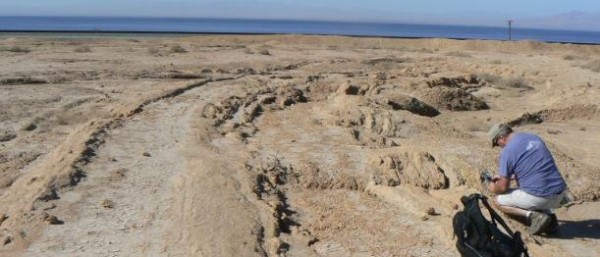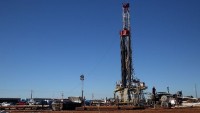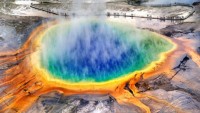New Fault in Earthquake-Prone Southern California might influence San Andreas Fault
| Arthur Dominic Villasanta | | Oct 10, 2016 02:44 AM EDT |
(Photo : Scripps Institution of Oceanography) Scripps geologist Neal Driscoll taking measurements of the onshore sediment layers along the eastern edge of the Salton Sea.
A newly mapped fault called the "Salton Trough Fault" in close proximity to the San Andreas Fault is raising concerns this anomaly might wind up causing a larger earthquake on the southern end of the notorious San Andreas Fault.
This apprehension follows a swarm of nearly 200 small earthquakes in a single 24 hour period (the most recorded for that period of time) that rattled Southern California residents in the Salton Sea area last week.
Like Us on Facebook
Scientists from Scripps Institution of Oceanography at the University of California San Diego and the Nevada Seismological Laboratory at the University of Nevada, Reno published their recent discovery of a potentially significant fault that lies along the eastern edge of the Salton Sea.
The presence of the Salton Trough Fault, which runs parallel to the San Andreas Fault, could impact current seismic hazard models in the earthquake-prone region that includes the greater Los Angeles area.
Mapping of earthquake faults provides important information for earthquake rupture and ground-shaking models, which helps protect lives and reduce property loss from these natural hazards.
"To aid in accurately assessing seismic hazard and reducing risk in a tectonically active region, it is crucial to correctly identify and locate faults before earthquakes happen," said Valerie Sahakian, a Scripps alumna, and lead author of the study.
The research team used a suite of instruments, including multi-channel seismic data, ocean-bottom seismometers, and light detection and ranging, or LIDAR, to precisely map the deformation within the various sediment layers in and around the sea's bottom. They imaged the newly identified strike-slip fault within the Salton Sea, just west of the San Andreas Fault.
"The location of the fault in the eastern Salton Sea has made imaging it difficult and there are no associated small seismic events, which is why the fault was not detected earlier," said Scripps geologist Neal Driscoll, the lead principal investigator of the NSF-funded project, and coauthor of the study.
"We employed the marine seismic equipment to define the deformation patterns beneath the sea that constrained the location of the fault."
Recent studies have revealed that the region has experienced magnitude 7 earthquakes roughly every 175 to 200 years for the last thousand years. A major rupture on the southern portion of the San Andreas Fault has not occurred in the last 300 years.
"The extended nature of time since the most recent earthquake on the Southern San Andreas has been puzzling to the earth sciences community," said Nevada State Seismologist Graham Kent, a coauthor of the study and former Scripps researcher.
"Based on the deformation patterns, this new fault has accommodated some of the strain from the larger San Andreas system, so without having a record of past earthquakes from this new fault, it's really difficult to determine whether this fault interacts with the southern San Andreas Fault at depth or in time."
Further research will help provide information into how the newly identified fault interacts with the southern San Andreas Fault, which may offer new insights into the more than 300-year period since the most recent earthquake.
TagsSalton Trough Fault, San Andreas Fault, california, Scripps Institution of Oceanography, Salton Sea
©2015 Chinatopix All rights reserved. Do not reproduce without permission
EDITOR'S PICKS
-

Did the Trump administration just announce plans for a trade war with ‘hostile’ China and Russia?
-

US Senate passes Taiwan travel bill slammed by China
-

As Yan Sihong’s family grieves, here are other Chinese students who went missing abroad. Some have never been found
-

Beijing blasts Western critics who ‘smear China’ with the term sharp power
-

China Envoy Seeks to Defuse Tensions With U.S. as a Trade War Brews
-

Singapore's Deputy PM Provides Bitcoin Vote of Confidence Amid China's Blanket Bans
-

China warns investors over risks in overseas virtual currency trading
-

Chinese government most trustworthy: survey
-

Kashima Antlers On Course For Back-To-Back Titles
MOST POPULAR
LATEST NEWS
Zhou Yongkang: China's Former Security Chief Sentenced to Life in Prison

China's former Chief of the Ministry of Public Security, Zhou Yongkang, has been given a life sentence after he was found guilty of abusing his office, bribery and deliberately ... Full Article
TRENDING STORY

China Pork Prices Expected to Stabilize As The Supplies Recover

Elephone P9000 Smartphone is now on Sale on Amazon India

There's a Big Chance Cliffhangers Won't Still Be Resolved When Grey's Anatomy Season 13 Returns

Supreme Court Ruled on Samsung vs Apple Dispute for Patent Infringement

Microsoft Surface Pro 5 Rumors and Release Date: What is the Latest?














